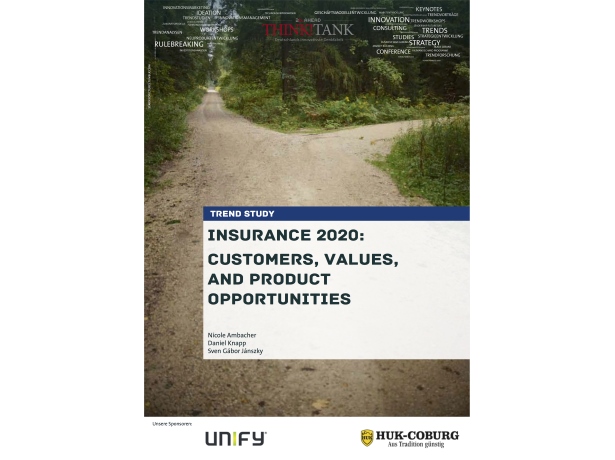Insurance 2020

Download
First, please enter the information requested below. The form must be filled out completely. Then, simply click on the "Download" button to download the file directly from our website. We guarantee that the personal data you submit will be used for internal purposes only, and will not be shared with any third parties.
Innovation in insurance models
Our new trend study, "Insurance 2020," was conducted in partnership with insurance carrier HUK Coburg and with Unify GmbH & Co. KG, provider for communications solutions and services. This qualitative study using the Delphi method is founded on the prognoses of 30 innovation managers, strategy leaders, and future experts.
This study provides a follow-up to the trend study "The Future of Insurance Companies," which had already caused an industry-wide sensation at the beginning of the year. That study represented the first successful reordering of customer segments in the industry for the digital era. "Insurance 2020" uses these new customer segments in the economy and premium markets as a basis, and investigates how the values of customers will change, which new risk areas will arise in society and in customers' everyday lives, and which new product opportunities will present themselves to insurance carriers.
"Insurance 2020" shows that, within the last few years, new areas of uncertainty have developed in our society that hold considerable business potential. Customers are perceiving new uncertainties in the areas of education, status, reputation, personal data, and mobility. These areas have hardly been covered by insurance products.
Fundamental change in values / Adaptive products / Privacy by design
The experts interviewed for the study diagnose a fundamental change in the values of customers in the insurance industry. The core value of customer trust is shifting due to technological change. While, years ago, it was the brands, brokers and representatives who enjoyed the greatest customer trust, large segments of customers in the future will come to primarily trust in digital assistance systems. These systems will lead to the appearance of a new product area: adaptive insurance products. Adaptive products react to their environment based on the data that they continuously collect and analyze. Using this data as a basis, adaptive products adapt themselves automatically at all times to the individual and constantly changing usage situations of the customer.
One essential factor for success here is the competent handling of sensitive data. This, however, does not mean an expansion of data protection or the reversal of technological developments. Rather, the big opportunity for insurers to react to this development lies in designing products with various privacy levels as early as the planning phase. This principle of "privacy by design" does, in fact, require more effort from insurers, but also represents an important distinctive feature of high-quality products. In the future, the release of personal data will be omnipresent among standardized mass-market products. In contrast, some customers in the premium market will be prepared to take on the costs of increased security and privacy. For that reason, products will be designed with 2-3 privacy levels. The basic level will meet legal requirements for data security, but generally will not include any further limitations for the protection of privacy.
The data collected will be distributed to all members of the data association over secured communication channels-e.g., to insurance carriers, brokers' organizations, risk profilers, and other service providers in that area of risk coverage. At higher privacy levels, there will be basic settings for the handling of sensitive data that will offer a high degree of privacy even to largely inexpert customers. At higher privacy levels, a retention of the data collected by a given device will also be possible.
28 strategic recommendations for business models of the future
The present study uses 28 strategic recommendations to demonstrate that established players in the industry are by no means helpless against attacks from the Internet sector, but rather have access to concrete, feasible measures for successfully changing their business models. Insurance carriers can make use of emerging uncertainties and transform them into product opportunities. These also include business models whose beginnings are already being pursued by niche players, such as group insurances and fee-based consulting.
Additionally, an upcoming break with industry conventions is announcing itself even today. For, while insurers' product development in the area of claims management is largely differentiated today, a new area is emerging which previously has seen virtually no competition: According to our study, insurance carriers will have considerable market opportunities in the near future to act as service providers for damage prevention and predictive risk management. Insurance companies that desire to take advantage of these product opportunities will become lifestyle guarantors for their customers, who will want more than compensation for damages in the future. Customers will much rather desire their insurance carriers to act as partners who can guarantee the continuation of the standard of living they have achieved.
Across six trend areas and 65 pages, "Insurance 2020" describes the upcoming changes in the insurance industry. The study takes an in-depth look at which areas will hold future potential for insurers, and where new business opportunities will emerge.
For options regarding the transfer of innovation from the trend study to your company, please click here.